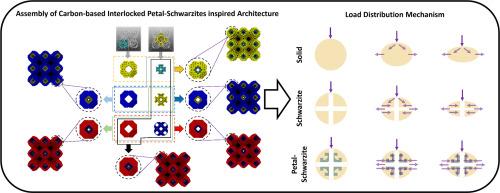Material extrusion of topologically engineered architecture inspired by carbon-based interlocked petal-schwarzites
IF 3.1
Q2 MATERIALS SCIENCE, MULTIDISCIPLINARY
引用次数: 0
Abstract
Exploiting the topologically engineered complex Schwarzite architecture has allowed the creation of innovative and distinctive structural elements possessing high specific strength. These fundamental building blocks' mechanical characteristics can be fine-tuned by reinforcing them with more robust architectures featuring high surface areas. In this work, we have fabricated six distinct Schwarzite-based structures composed of multiple interlocked layers, termed architecturally interlocked petal-schwarzites. These intricate structures have been additively manufactured into macroscopic dimensions and subjected to uniaxial compression. Experimental findings reveal a correlation between the mechanical response and the number of layers. Additionally, fully atomistic molecular dynamics compressive simulations have been carried out, yielding results that are in good agreement with the experimental observations. These simulations provide insights into the underlying mechanism of high specific strength and energy absorption exhibited by architecturally interlocked petal-schwarzites. The proposed methodology introduces a new perspective on the development of engineered additively manufactured materials with tunable and enhanced mechanical properties.

受碳基互锁花瓣石启发的拓扑工程结构的材料挤压工艺
利用拓扑工程复杂的施瓦兹石结构,可以创造出具有高比强度的创新型独特结构元素。这些基本构件的机械特性可以通过用具有高比表面积的更坚固结构对其进行加固来进行微调。在这项工作中,我们制造了六种不同的基于施瓦茨石的结构,这些结构由多个互锁层组成,被称为架构互锁花瓣施瓦茨石。这些错综复杂的结构是用添加剂制造的,具有宏观尺寸,并受到单轴压缩。实验结果表明,机械响应与层数之间存在相关性。此外,还进行了全原子分子动力学压缩模拟,结果与实验观察结果十分吻合。这些模拟深入揭示了建筑互锁花瓣状华夏石所表现出的高比强度和高能量吸收的内在机制。所提出的方法为开发具有可调和增强机械性能的工程添加制造材料提供了新的视角。
本文章由计算机程序翻译,如有差异,请以英文原文为准。
求助全文
约1分钟内获得全文
求助全文
来源期刊

Carbon Trends
Materials Science-Materials Science (miscellaneous)
CiteScore
4.60
自引率
0.00%
发文量
88
审稿时长
77 days
 求助内容:
求助内容: 应助结果提醒方式:
应助结果提醒方式:


